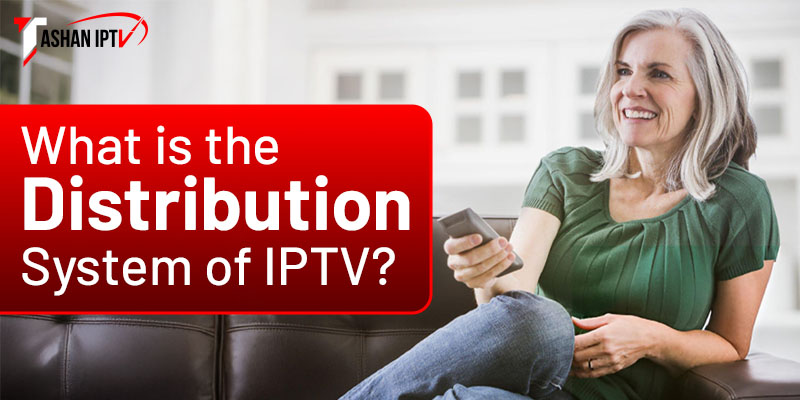24x7 Customer Support
24x7 Customer Support

IPTV stands for Internet Protocol Television. It means watching TV over the internet instead of using cable or satellite services. Many people use IPTV today because it offers more control over what to watch and when to watch it.
Behind the scenes, IPTV depends on a smart system that moves video from the source to your screen. This is called the IPTV distribution system. Without it, videos can’t reach viewers smoothly. This blog will explain how IPTV distribution works, how each part fits together, and why it’s different from regular TV.
The IPTV distribution system is the setup that delivers TV channels and videos over an internet connection. It carries the signal from the content provider to the viewer’s screen, using a computer network instead of satellite or coaxial cable.
The system works by turning the TV signal into digital data. That data travels through IP (Internet Protocol) networks to reach users. This method allows IPTV providers to stream live channels, movies, and shows directly to TVs, phones, and other smart devices.
Unlike traditional TV, which sends signals to everyone the same way, IPTV can send specific content to each person. So, one person can watch a live match while another enjoys a movie—at the same time, using the same internet network.
Every IPTV system needs certain tools and parts to work properly. Let’s look at the main components of the IPTV distribution system:
This is the starting point. It collects TV channels, live feeds, and other video sources. After collecting, it encodes them into a digital format that can travel through the internet. This is where content becomes ready for online delivery. This part is often called IPTV headend distribution.
Middleware is software that helps users interact with the IPTV service. It manages the interface, user accounts, channel lists, and video-on-demand menus. It also controls how content is sorted and delivered to each viewer.
A CDN helps move video content across large areas. It stores copies of videos in different servers around the world. When someone plays a video, the CDN picks the nearest server to send the content. This reduces lag and keeps the stream smooth.
These are the screens where people watch IPTV. It includes Smart TVs, set-top boxes (STBs), mobile apps, tablets, and even web browsers on computers. The device connects to the IPTV server and plays the video.
Let’s break down the process of how content is delivered in IPTV, step by step.
TV shows, sports matches, and movies are gathered from different sources. These can include satellite feeds, cameras, or existing video files.
The raw content is turned into a digital format using video encoders. The files are also compressed so they use less bandwidth but still look clear.
After compression, the content is split into smaller packets. Each packet includes a piece of the video and instructions for delivery. This helps with smooth playback even if there’s a small internet hiccup.
The packets travel over the internet to the user’s device. The network knows how to find the best path to send the data quickly and correctly.
The device at the end joins all the packets back into a full video stream. It plays the content using a media player or app.
Think of it like water flowing from a big tank. The tank stores water (video), pipes carry the water (internet), and taps (devices) let you access it when you want.
This is the idea behind IPTV streaming distribution technology.
There are different ways IPTV content can be shared across users. These include how the signal is sent and how the system is set up.
These differences make up the types of IPTV distribution systems and shape how well they perform.
IPTV is different from regular cable or satellite TV. Traditional systems send signals through cables or dishes, and everyone gets the same thing at the same time.
With IPTV, each person can choose what to watch. The system sends content on request. This makes it more flexible. Users can pause, rewind, or choose a new show anytime.
Also, IPTV works on more devices. You don’t need special wiring—just an internet connection. This gives IPTV better reach and more choices for users.
So, the difference between IPTV and traditional TV distribution is clear: one is fixed, the other is flexible and on-demand.
Even though IPTV has many strengths, it also faces some issues. These issues might make the system not work the way it should.
If many users stream high-quality video at once, the network can get overloaded. This slows down streaming and can cause buffering.
Sometimes, there’s a delay between what happens and when it plays on screen. This is a problem for live sports or real-time news.
Older TVs or weak devices may not handle high-speed video well. They might crash or fail to play newer formats.
To fix these issues, IPTV providers use smart servers, stronger compression tools, and faster networks. They also update their apps to support more devices.
The distribution system of IPTV is what makes online TV work the way it does. It gathers channels and shows, gets them ready, and sends them over the internet to your screen. With key tools like the headend, middleware, and CDNs, IPTV lets people watch what they want—when and where they want.
Understanding how this system runs helps both viewers and businesses make smart choices. Whether you’re setting it up at home or in a hotel, knowing the basics can save time and avoid frustration.
If you’re looking for a service that runs smoothly across setups and delivers solid quality, Vois IPTV is worth checking out. It brings together top channels, reliable streams, and a setup that doesn’t take much effort. Whether you’re new to IPTV or already using it, Vois IPTV makes things easier.